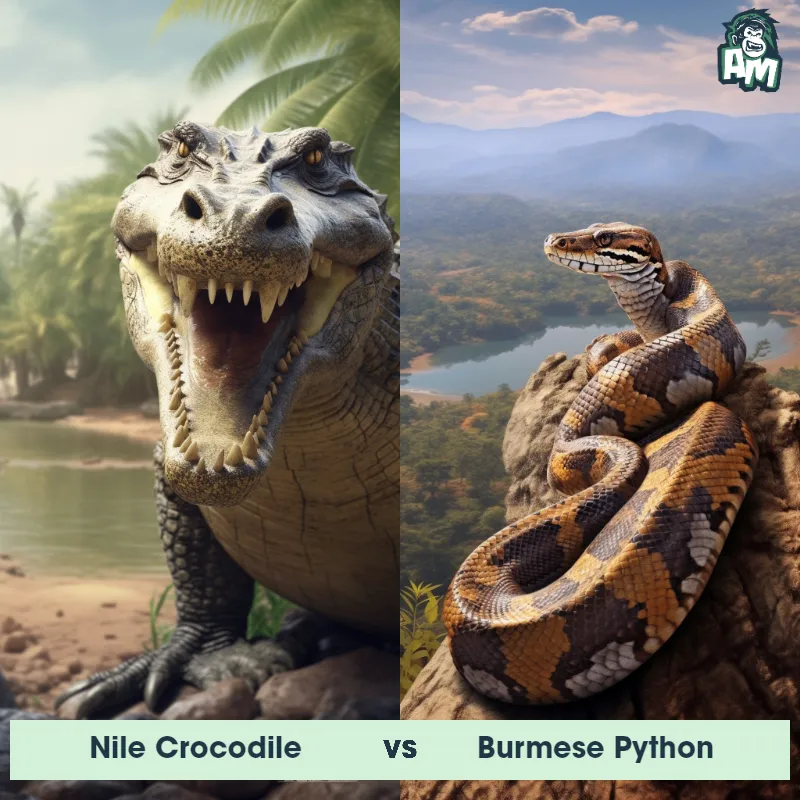The Burmese Python
The Burmese Python, scientifically known as Python bivittatus, is one of the largest snake species in the world. They are native to Southeast Asia, specifically found in Myanmar, Thailand, and surrounding regions. These pythons can grow up to 23 feet in length and weigh over 200 pounds. They have a distinctive pattern of dark-brown patches outlined in lighter beige or golden coloration, providing excellent camouflaging abilities in their natural habitats. Burmese pythons are nonvenomous constrictors, meaning they kill their prey by squeezing them until they cannot breathe.

| Burmese Python | |
|---|---|
| Size | Up to 23 feet (7 meters) |
| Weight | Up to 200 pounds (91 kilograms) |
| Speed | Speed: 5 mph (8 km/hr) |
| Key Strength | Constriction |
| Biggest Weakness | Vulnerable to attacks on the head |
| Scientific Name | Python bivittatus |
| Family | Pythonidae |
| Habitat | Terrestrial |
| Geography | Southeast Asia |
| Diet | Carnivorous, preys on mammals, birds, and reptiles |
| Lifespan | 20 years - 30 years |

The Burmese Python
The Burmese Python, scientifically known as Python bivittatus, is one of the largest snake species in the world. They are native to Southeast Asia, specifically found in Myanmar, Thailand, and surrounding regions. These pythons can grow up to 23 feet in length and weigh over 200 pounds. They have a distinctive pattern of dark-brown patches outlined in lighter beige or golden coloration, providing excellent camouflaging abilities in their natural habitats. Burmese pythons are nonvenomous constrictors, meaning they kill their prey by squeezing them until they cannot breathe.
Fun Fact: The Burmese Python has the ability to dislocate their jaws, allowing them to swallow prey much larger than their head, such as deer or even alligators.
| Burmese Python | |
|---|---|
| Size | Up to 23 feet (7 meters) |
| Weight | Up to 200 pounds (91 kilograms) |
| Speed | Speed: 5 mph (8 km/hr) |
| Key Strength | Constriction |
| Biggest Weakness | Vulnerable to attacks on the head |
| Scientific Name | Python bivittatus |
| Family | Pythonidae |
| Habitat | Terrestrial |
| Geography | Southeast Asia |
| Diet | Carnivorous, preys on mammals, birds, and reptiles |
| Lifespan | 20 years - 30 years |
Match Highlights
Burmese Python Matchups
We use AI to simulate matchups between the Burmese Python and other animals. Our simulation considers size, strength, and natural predatory behaviors to determine the most likely outcome.

Can't find the Matchup you want?
Create Your Own MatchupBurmese Python: Diet, Predators, Aggression, and Defensive Behaviors
What do Burmese Pythons eat?
Burmese Pythons are carnivorous snakes that primarily feed on small mammals like rats, mice, and rabbits. However, they are also known to prey on larger animals such as birds, lizards, and even deer. As ambush predators, they use their powerful coils to constrict and suffocate their prey before swallowing it whole.
Do Burmese Pythons have any predators?
As apex predators, Burmese Pythons do not have many natural predators in their native habitat. However, larger predators like crocodiles and big cats have been known to prey on young or smaller pythons. Humans are also a significant threat to Burmese Pythons through hunting, habitat destruction, and the pet trade.
Are Burmese Pythons aggressive?
Burmese Pythons are not typically aggressive towards humans unless they feel threatened or provoked. They may exhibit defensive behaviors like hissing, striking, or coiling up in a defensive stance when they perceive a threat. In the wild, their main focus is on hunting for food rather than seeking out confrontation.
Do Burmese Pythons fight with other snakes?
Burmese Pythons are solitary animals and are not known to engage in fights with other snakes. They may come into competition with other pythons for food, territory, or mates, but conflicts are typically resolved through intimidation displays and avoidance behaviors rather than physical combat.
How do Burmese Pythons defend themselves?
When threatened, Burmese Pythons have several defensive mechanisms to protect themselves. They may hiss loudly, strike with their sharp teeth, or coil their bodies tightly to appear larger and more intimidating. Their primary defense, however, is their ability to camouflage and remain hidden from potential threats.
What is the biggest weakness of the Burmese Python in a fight?
Despite their impressive size and strength, the biggest weakness of Burmese Pythons in a fight is their vulnerability to being overpowered by larger predators or prey. While their constricting coils are effective at subduing most animals, they can be overwhelmed by stronger opponents that are able to resist or escape their grasp. Additionally, their slow metabolism means they must conserve energy and choose their battles wisely.
Fun Fact: Burmese Pythons are excellent swimmers and are known to spend a significant amount of time in the water, even crossing large bodies of water such as rivers and lakes.
Fun Fact: These pythons are considered invasive and have become a significant ecological threat in certain areas, such as the Florida Everglades, where they were introduced by humans. They have established breeding populations and are threatening native wildlife, including birds, mammals, and reptiles, causing declines in their populations.





















